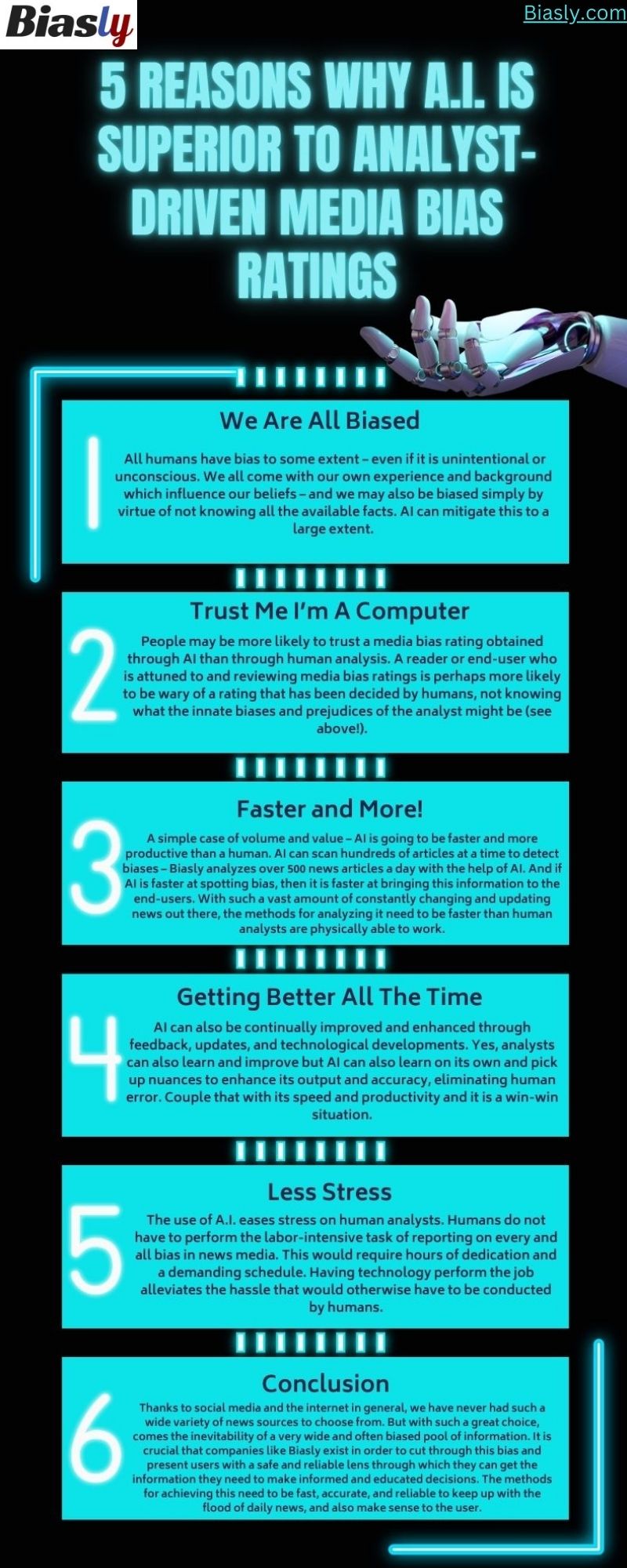
According to the AI for Good website, only half of US adults feel that there are enough sources online to allow people to see through any bias in the news – down from 66% in the previous generation. The news has never been more influential in driving social behaviors and influencing how people think and act. It is crucial now more than ever for companies like Biasly to utilize optimum methods for determining and monitoring bias in the news.
When it comes to analyzing media bias, companies can use methods that are primarily driven by either analysts or by artificial intelligence.
AI bias ratings use algorithms that specialize in identifying words and phrases to detect biases and leanings in articles and news sources. Human or analyst-driven ratings do what they say on the label. Individuals are responsible for reviewing news sources and determining political leanings or different types of bias. This can be done through surveys, media comparisons or study of the use of words and phrases.
We will take a look at five reasons why we believe that AI media bias ratings are better than analyst-driven in giving readers and users a clear and accurate picture of biases in the news.
We are all biased
In the same way that it is not really possible to have a completely neutral journalist, it is not possible to have a completely neutral analyst. All humans have bias to some extent – even if it is unintentional or unconscious. We all come with our own experience and background which influence our beliefs – and we may also be biased simply by virtue of not knowing all the available facts. AI can mitigate this to a large extent.
Trust me I’m a computer
People may be more likely to trust a media bias rating obtained through AI than through human analysis. A reader or end-user who is attuned to and reviewing media bias ratings is perhaps more likely to be wary of a rating that has been decided by humans, not knowing what the innate biases and prejudices of the analyst might be (see above!).
Faster and More!
A simple case of volume and value – AI is going to be faster and more productive than a human. AI can scan hundreds of articles at a time to detect biases – Biasly analyzes over 500 news articles a day with the help of AI. And if AI is faster at spotting bias, then it is faster at bringing this information to the end-users. With such a vast amount of constantly changing and updating news out there, the methods for analyzing it need to be faster than human analysts are physically able to work.
Getting Better All The Time
AI can also be continually improved and enhanced through feedback, updates, and technological developments. Yes, analysts can also learn and improve but AI can also learn on its own and pick up nuances to enhance its output and accuracy, eliminating human error. Couple that with its speed and productivity and it is a win-win situation.
Not so win-win for the world’s number one “Go” player Ke Jie, who was defeated in 2017 by Google’s AI player, AlphaGo. “Go”, which has been played in China for thousands of years, is believed to be more complex than chess with an infinite number of outcomes. AlphaGo AI has continued to improve and dominate to the point of forcing master Go player Lee-Se dol into retirement, claiming that AI is ‘…an entity that cannot be defeated.’
Less Stress
The use of A.I. eases stress on human analysts. Humans do not have to perform the labor-intensive task of reporting on every and all bias in news media. This would require hours of dedication and a demanding schedule. Having technology perform the job alleviates the hassle that would otherwise have to be conducted by humans.
Conclusion
Thanks to social media and the internet in general, we have never had such a wide variety of news sources to choose from. But with such a great choice, comes the inevitability of a very wide and often biased pool of information. It is crucial that companies like Biasly exist in order to cut through this bias and present users with a safe and reliable lens through which they can get the information they need to make informed and educated decisions. The methods for achieving this need to be fast, accurate, and reliable to keep up with the flood of daily news, and also make sense to the user. Whilst studies, polls, and ongoing intellectual research by human analysts play an important role in monitoring and developing media bias ratings, AI is pivotal in being able to deal with the speed and accuracy required for the mammoth and important task in hand.























